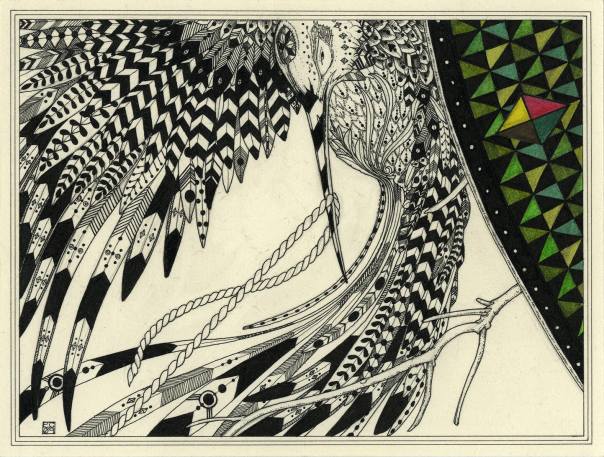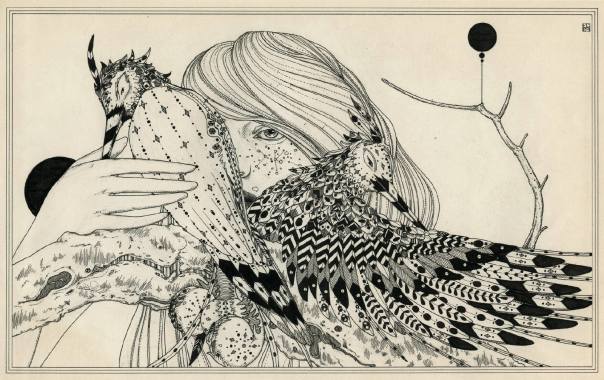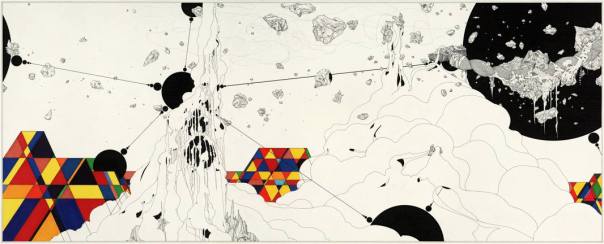
Philapore Tug (Due Tension), 2009
4.25 x 5 Inches. Ink, marker and graphite on paper © Ernesto Caivano
If there’s one thing we all have in common, it’s fondness of a good yarn. Stories are passed down for generations, sometimes over the course of centuries. We read them in magazines and see them performed on television, in the theatre and on the big screen. We read novels and biographies, picture books and comics. We sing them and celebrate them.
So what place does the fictional narrative have in Fine Art? While most people’s thoughts will immediately flicker to the rapturous brushstrokes of the Pre-Raphaelites or the classical painters, contemporary artist Ernesto Caivano has striking and enigmatic methods of putting his own epic narrative on paper.

Philapore Tug (Due Tension), 2009
4.25 x 5 Inches. Ink, marker and graphite on paper © Ernesto Caivano
It seems that all Caivano needs is some paper and ink. Give him these materials and the outcome will be a delicate, complex and alluring image, both in technique and concept. Take, for instance, Breathing Through the Code, in which we see one of the protagonists in the artist’s ongoing story After the Woods. Her name is Polygon, and one can assume here that she is communicating with her lover-from-afar – the knight Versus – via what Caivano has titled Philapores (they are the birds that you see in the images).
According to Caivano, Polygon and Versus are lovers who were separated a millennia ago. His drawings depict their attempted reunification in the near future on a cosmic, geometrically ambiguous world. Versus’ powers reside in the growth and evolution of plants, Polygon’s in the capacity and possibilities of technology (she herself is epitomised as a spaceship). Their only communication relies on the Philapores. It is these narratives that Caivano illustrates within the scope of Versus’ and Polygon’s wider universe.

Suspension of Elements (A Kind of Reassembly), 2009
18.25 x 45.25 Inches. Ink and graphite on paper © Ernesto Caivano
Innumerable possible interpretations lie within each image, as is the case for the narrative as a whole. Brian Sholis writes in Vitamin D: New Perspectives in Drawing (2005) that “the story can be seen as a metaphor for our attempts to reconcile technological development with non-human life and the natural environment”. Visual allusions to molecular physics and fractal geometry reside alongside more literary medieval references, forming an almost archetypal narrative that brims with nostalgia and trepidation.
And yet despite this apparent complexity Caivano is far less ambiguous than his artwork. As to the fate of his protagonists, of the Philapores and of the beautifully sinister cosmos in After the Woods, he is deliberate about not stipulating direct connotations and meanings. Even he doesn’t know how the narrative will end. I suppose that’s the success behind any good story. We can only look on and wait to see whether or not longing will be transformed into reunification. But whilst After the Woods may resemble fairy tales in some respects, fairy tales by nature are not as delectable as one may first assume. After all, there’s nothing more boring than reading a story and seeing the words ‘happily ever after’ written at the end.
You can find more images of Ernesto Caivano’s artwork at the Richard Heller Gallery website.
This post was originally written for Guy.com’s Daily Slice.

